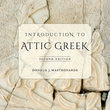 Accentuation Tutorial
Accentuation Tutorial

|
TOPICS Accent and Accent-Marking in Ancient Greek Contonation and Mora The Last 3 Syllables and the Accents Persistent Accentuation |
A mora is the (theoretically assigned) “standard” length of a short vowel (ᾰ, ε, ῐ, ο, ῠ, and final αι and οι in most cases). A long vowel (ᾱ, ει, η, ῑ, ου, ω, ῡ) or a diphthong (except final αι and οι in most cases) occupies (theoretically) a time span equivalent to two morae. The general principle of Greek accentuation is that the contonation may be followed by no more than on mora before the end of the word (or phrase pronounced as one word unit). This principle is in many respects similar to rules in other languages (e.g., Latin) that constrain the position of the accent according to the nature of the final syllables of a word. In Greek this principle limits the position of the acute and circumflex accents and requires the addition of an extra accent in some phrases consisting of word + enclitic.

|
||||